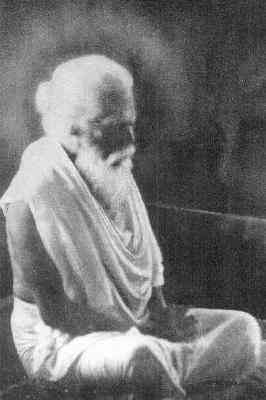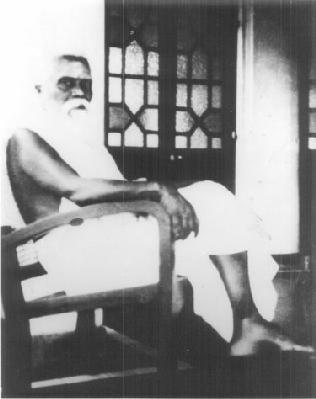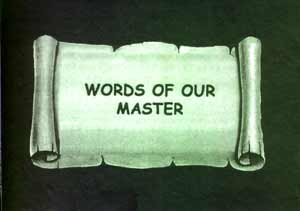|
| ||||
 Yoga Swami: The Sage of Lankaby Santhaswami (Viscount Lord Soulbury)
Colombo: The Island, 4th June 1995The 123rd birth anniversary of Yoga Swami fell on 21st May 1995. The following article was written by Santhaswami who was the elder son of the late Lord Soulbury, former Governor-General of Sri Lanka. On the death of his father, he inherited his viscountcy and became a member of the House of Lords. He had sought Yoga Swami's permission to renounce his viscountcy in favour of his younger brother, but Swami refused. Instead, he initiated him and gave him the name Santhaswami. The fundamental aim of all religions is the realization of Truth. This is a matter of direct experience in which neither the mind nor the intellect nor any human faculty is involved. It is a question of being. There is only one reality, which is God or 'That' (tat) so that realization of truth means being aware that you are one with God or that you are "that' (Tat tvam asi). This is the meaning of 'know thyself'. He who knows himself knows everything and is one who has attained liberation while in the human body (jivanmukta). There is nothing left for him to do but to help others to come to the same realization. Such a person is the true master (sat-guru). Those who have attained this state are exceedingly rare. But one such 'realized soul' lived in the North of Sri Lanka for over ninety years and left his body only in March 1964. He was known as Yoga Swami and took birth a hundred and twenty-one years ago. He received his early education in a Christian missionary school and, either tan or later, acquired a good knowledge of English. After leaving school, he was employed for some years as a storekeeper in the Irrigation Department at a place about forty miles south of Jaffna. During this time, in his early manhood, he met his guru -- Chellappa Swami. Soon afterwards he gave up his job -- and everything else -- in order to follow him. Thirst for truth This was Chellappa Swami's favourite haunt and the place where the imparted most of his teaching to his disciples. He did not do anything but wandered about as he pleased, clothed in rags and begging for food for his sustenance. Most people thought that he was mad, for he would often throw stones at those who tried to approach him and abuse them in language. Only very few had the purity of mind and heart and understanding to perceive his true greatness and to detect the unlimited wealth that he had in his power to bestow. Yoga Swami was one of the lucky few. Even he was chastened and driven out many a time, but Yoga Swami withstood all these because of his thirst for realizing the Truth. Driven out During the eyars immediately before and after Chellappa Swami's Mahāsamādhi, Yoga Swami was living under a tree at Columbuthurai on the outskirts of Jaffna town. At this time he appears to have been practising severe austerities and in his outward behaviour to have followed the example of his master, for he would drive away those who tried to approach him. But gradually, as more and more devotees gathered round him, his austere demeanour seems to have been relaxed, and he was eventually persuaded to occupy a small hut in the garden of a house near the tree under which he had been living. This remained his 'base' for the rest of his life. There devotees would come to him for help in all their problems, usually in the early mornings and in the evenings. Teachings Nearly all his devotees were householders and engaged in some employment or other, and apart from one or two exceptions, he rarely advised them to retire from their employment. People would often come and say that they wanted to give up their jobs in order to be able to devote more time to spiritual practices but he did not usually encourage them to do this, since, for him, the whole of man's life had to be made a spiritual practice and he would not admit any division of human activity into holy and unholy. Work
As his followers became more and more numerous, he gave them work to do and encouraged them to translate into Tamil a few writings in Sanskrit or English that he considered to be important. In 1953 he made them start a monthly paper devoted exclusively to religious subjects. In every issue would appear one of his songs. These songs, to which he gave the name of Natchyintanai -- that is, 'Good Thoughts' -- flowed from him spontaneously and might come forth at any moment. In 1935 he sanctioned, at the desire of some of his followers, the establishment of a place in Jaffna town where they could meet and this developed into a centre where they were able to practise meditation, sing devotional songs, hold classes in religion and philosophy and generally carry on any activities useful for spiritual growth. Sivathondan Everything is God's work and in one sense everyone, every being, is doing Sivathondan. But man has won the unique privilege of being able to do it consciously. To make use of this rare opportunity is the best and easiest way open to him in this age of purifying himself, subjugating his ego and attaining therely that unalloyed happiness which is his birthright.
For more about Yoga Swami, see:
|
| Living Heritage Trust ©2021 All Rights Reserved |
 Good thoughts
Good thoughts
